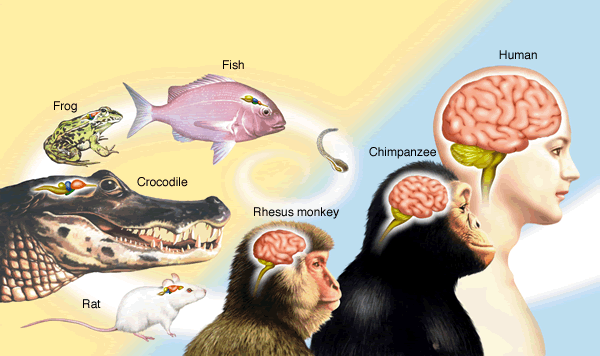How Special is Human Breast Milk? Part II
Part I discussed that humans, and primates in general, produce low fat milk relative to other mammals. But wait! Humans tend to pride ourselves on our big brains, strutting our mental muscles on the boardwalk of evolution (suck it frog!).
And long-chain polyunsaturated fatty acids (LCPUFA) in milk are implicated in neurodevelopment and cognition. This suggests that that even if human milk is low fat, there must be something special about that fat, right?
And long-chain polyunsaturated fatty acids (LCPUFA) in milk are implicated in neurodevelopment and cognition. This suggests that that even if human milk is low fat, there must be something special about that fat, right?
Right?!?
Maybe, but not in the way you think. Lauren Milligan and Richard Bazinet compared the fatty acid profiles of the milk 16 species of primates (representing 81 individuals!). According to Milligan and Bazinet, “humans are not unique in our ability to secrete LCPUFA in milk, but are unique in our access to dietary LCPUFA.” Captive primates eat food that is commercially manufactured from agricultural ingredients, including animal proteins. And fatty acid profiles in human and captive primate milk look very similar because they are actually consuming a very similar diet. Women consuming a “Western” diet have 0.32% DHA (omega-3) in milk, whereas women consuming a lot of fish have 0.93% DHA, but vegetarian and vegan women have 0.22% and 0.14% DHA respectively. Captive primates produce milk with 0.35% DHA, but wild-living primates consuming ancestral diets produce milk with 0.11% DHA. The foods we produce, acquire, and prepare- which vary in part due to individual preferences and cultural practices- determine fatty acid profiles in milk.
But does this matter for cognition when the differences between taxa are on par with the variance among and within human populations?
Research from Avshalom Caspi’s lab suggests that the infant’s utilization of fatty acids is as important as the presence of fatty acids in milk. Many studies show that breastfeeding is associated with higher IQ in childhood- and into adulthood- than is formula-feeding. Indeed such results sparked the inclusion of LCPUFA in commercial infant formulas. Caspi et al. showed that the effects of breastfeeding on IQ are mediated by genetic variation in fatty acid metabolism pathways. Their candidate gene- FADS2- is instrumental in fatty acid metabolic pathways. Infants were either CC or GG homozygous or CG heterozygous, and on their own these genotypes were not associated with IQ. However, individuals who were breastfed AND carried the C allele (either CC or CG) had a ~6 points higher IQ than individuals with the C allele who were formula fed (before the inclusion of DHA in formula). In contrast GG individuals showed no differences in IQ whether or not they were breast- or formula-fed. The real kicker though, is that breast-fed C-allele carriers had significantly higher IQ than GG individuals, suggesting that the C allele confers a benefit in utilization of ingested fatty acids. Importantly, this study controlled for numerous factors, such as maternal IQ, fetal growth, socioeconomic status. However Caspi's group did not look at variation in milk fatty acids among breast-feeding mothers, just compared whether an individual was breast-fed vs. formula-fed.
As an evolutionary biologist, I have a number of questions. Are there FADS2 polymorphisms analogues in non-human mammals? And in humans, if the C-allele confers such a benefit (and we can debate the benefit of 4-6 IQ points), why isn’t everyone CC? In Caspi’s study, 47% of the 2706 subjects had 1 or 2 copies of the G allele. Its not like natural selection hasn’t had the time to bring C to fixation, right? Heterozygotic CG and homozygotic GG individuals are still running around, despite the fact that breast-feeding was obligatory until the advent of commercial formula by Henri Nestle in 1867, suggesting that there is likely a benefit to the G allele, maintaining it in the population. What might that be?
Pretty much every post could conclude with this point, but clearly we need to know A LOT more about mother’s milk, breastfeeding, fatty acid metabolism, and neurodevelopment. Psst- granting agencies: ding ding ding.
Also, for the record, frogs are awesome! Ask Tara Chestnut.
Further Reading:
Milligan LA, Bazinet RP. 2008. Evolutionary modifications of human milk composition: evidence from long-chain polyunsaturated fatty acid composition of anthropoid milks. J Hum Evol. 55(6): 1086-95.
Milligan et al. 2008. Fatty acid composition of wild anthropoid primate milks. Comp Biochem Physiol B Biochem Mol Biol. 149(1):74-82.
Caspi A, Williams B, Kim-Cohen J, Craig IW, Milne BJ, Poulton R, Schalkwyk LC, Taylor A, Werts H, Moffitt TE. 2007. Moderation of breastfeeding effects on the IQ by genetic variation in fatty acid metabolism. Proc Natl Acad Sci. 104(47):18860-5
image credit: http://www.svtr.org/images/0RISKY_compare-brains.gif



Comments
Post a Comment